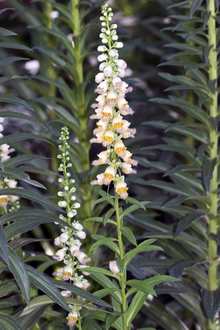Quick facts
Grecian foxglove is an invasive species.
- Grecian foxglove can be found in savannas and prairie communities.
- It grows in single species stands.
WARNING: This plant is toxic to humans and animals. Toxins can be absorbed through skin. Wear protective clothing and gloves when handling.
Grecian foxglove should be reported. The Minnesota Department of Natural Resources provides detailed recommendations for reporting invasive species.
How to identify Grecian foxglove
- Grecian foxglove (Digitalis lanata) is a perennial herbaceous plant that grows as a rosette for the first year then bolts to a single stemmed flower in subsequent years.
Stem
- Second and subsequent years a single coarse, vertical, woolly-haired, purple-tinged stem emerges.
Leaves
- First-year rosette leaves are dark green and oblong shaped with a pointed tip.
- Second-year leaves are medium green, simple and oblong with a woolly underside and pointed tips; alternately arranged along the stem.
Flowers
- Conspicuous, elongated flower clusters ascend up the stem.
- Tubular, bell-shaped flowers are cream colored with purplish-brown veins.
- Blooms in June.
Seeds
- Oval pods with small hooks attach easily to fur and clothes.
- Each pod contains many seeds.
- Seeds are the only means of reproduction.
Reviewed in 2019



